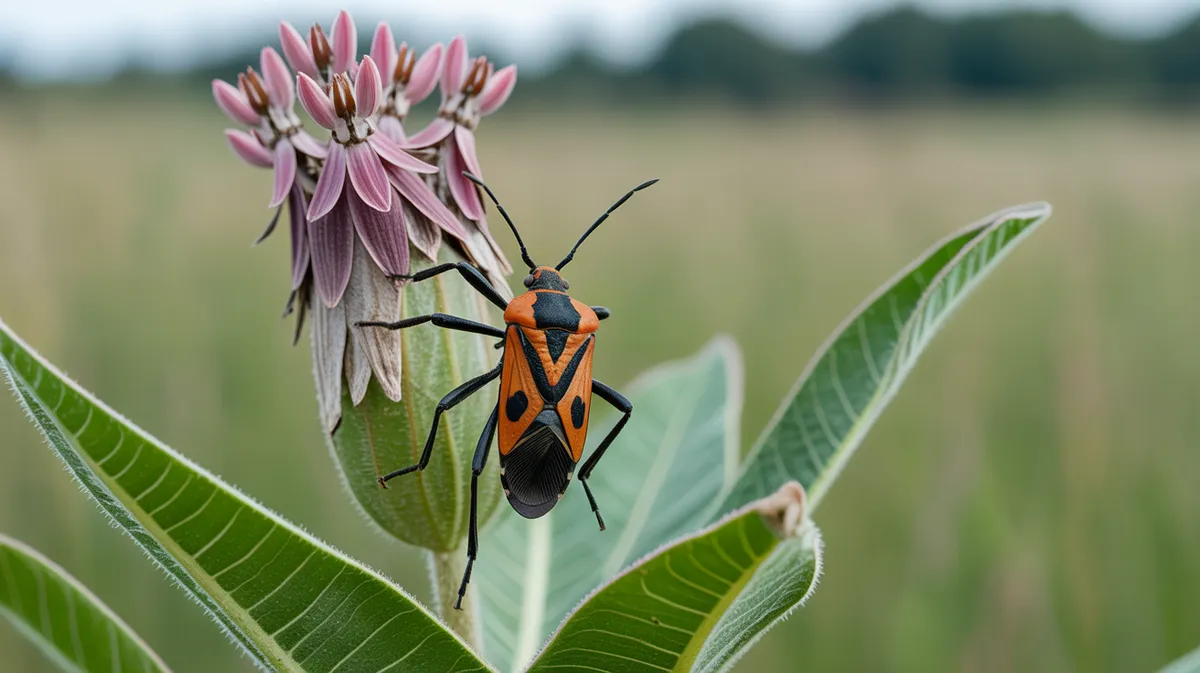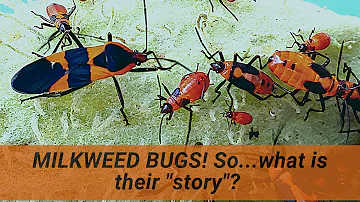
Large Milkweed Bug
Oncopeltus fasciatus

Meet the Large Milkweed Bug
The large milkweed bug is a brightly colored insect commonly found on milkweed plants throughout North America. Recognizable by its vivid orange and black pattern, this bug specializes in feeding on the seeds, leaves, and stems of milkweed. Its coloration serves as a warning to predators, since the toxins it acquires from milkweed make it unpalatable. Large milkweed bugs play an important ecological role as seed predators and as prey for certain birds and insects.
Classification
Invertebrate
Habitat
Open fields and meadows with abundant milkweed plants
Diet
Herbivore
Lifespan
1-2 months
Conservation
Least Concern
Weight
0.03-0.06 grams
📖Fascinating Facts
Bright Warning Colors
The large milkweed bug's orange-and-black pattern is a warning signal to predators that it is toxic and distasteful.
Milkweed Specialist
This insect feeds almost exclusively on milkweed plants, deriving both food and chemical defenses from them.
Simple Life Cycle
Milkweed bugs undergo incomplete metamorphosis, developing from eggs to nymphs to adults without a pupal stage.
📋Detailed Description
The large milkweed bug (Oncopeltus fasciatus) is a strikingly colored true bug, measuring 10–18 mm in length, with a distinctive orange-red and black aposematic pattern. Its elongated, oval-shaped body is flattened dorsoventrally, and it possesses long, slender legs and antennae, which aid in mobility and sensory perception. The forewings are partially hardened (hemelytra), with the basal portion leathery and the distal portion membranous, a typical feature of Hemiptera. The mouthparts are adapted for piercing and sucking, forming a beak-like rostrum used to feed on plant fluids. O. fasciatus is primarily associated with milkweed plants (Asclepias spp.), from which it sequesters toxic cardenolides, rendering it distasteful to many predators. The species exhibits both macropterous (long-winged) and brachypterous (short-winged) morphs, with wing length varying geographically and seasonally. Large milkweed bugs are gregarious, especially in the nymphal stages, often forming dense aggregations on host plants. Their life cycle includes incomplete metamorphosis: eggs hatch into nymphs that undergo five molts before reaching adulthood. Reproduction is prolific, with females laying hundreds of eggs during their lifespan. The species is an important model organism in developmental biology and evolutionary ecology due to its ease of rearing and well-characterized genetics.
💡 Did you know?
Milkweed bugs have specialized mouthparts that allow them to pierce and suck nutrients from seeds and stems, making them highly adapted to their food source.
🔬Research & Sources
Wikipedia Summary
Oncopeltus fasciatus, known as the large milkweed bug, is a medium-sized hemipteran of the family Lygaeidae. It is distributed throughout North America, from Central America through Mexico and the Caribbean to southern areas in Canada. Costa Rica represents this insect's southern limit. It inhabits disturbed areas, roadsides, and open pastures. Due to this widespread geographic distribution, this insect exhibits varying life history trade-offs depending on the population location, including differences in wing length and other traits based on location.
Last Modified: 1/12/2025
🎭Behavior & Social Structure
Large milkweed bugs are diurnal and exhibit a strong preference for sunny, open habitats where milkweed is abundant. Feeding behavior is specialized: both nymphs and adults use their rostrum to pierce milkweed seeds, stems, and occasionally leaves, extracting sap and nutrients. They are not aggressive and rarely interact antagonistically, though competition for food resources can occur in crowded conditions. Socially, nymphs aggregate in large groups, which may enhance their aposematic signaling and reduce predation risk. Adults are more solitary but may congregate for mating or feeding. Defensive behaviors include reflex bleeding, where the bug exudes a foul-tasting fluid from its joints when threatened. Predators include birds, spiders, and assassin bugs, but the sequestered milkweed toxins provide significant chemical defense. Daily routines involve basking for thermoregulation, active feeding during daylight, and reduced activity at night.
👶Reproduction & Life Cycle
Mating in O. fasciatus is characterized by prolonged copulation, often lasting several hours, which is thought to ensure sperm transfer and guard against rival males. Females lay clusters of 25–50 eggs, typically in crevices of milkweed pods or stems. The eggs are orange and hatch in 4–7 days, depending on temperature. Nymphs progress through five instars over 3–4 weeks, with development rates influenced by temperature and food quality. There is no parental care; after oviposition, adults do not tend to the eggs or young. In warmer climates, multiple generations (up to three or four) may occur per year, while in northern regions, development is often synchronized with the growing season of milkweed. Overwintering occurs in the adult stage, with individuals seeking shelter in leaf litter or under bark.
🛡️Adaptations & Survival
O. fasciatus displays several key adaptations for survival. Its aposematic coloration warns predators of its toxicity, a result of sequestering cardenolides from milkweed. The species has evolved resistance to these toxins through mutations in the Na+/K+-ATPase enzyme, a classic example of convergent evolution among milkweed specialists. The piercing-sucking mouthparts are highly efficient for extracting plant fluids. Wing polymorphism allows adaptation to local environments: long-winged forms are capable of dispersal, while short-winged forms invest more in reproduction. Aggregation in nymphs enhances warning signal efficacy and may reduce individual predation risk. Rapid development and high fecundity enable quick population growth in favorable conditions.
📚Research Sources
🎨Cultural Significance
While O. fasciatus does not have a prominent role in folklore or traditional medicine, it is valued in scientific research as a model organism for studies in genetics, physiology, and evolutionary biology. Its vivid coloration and association with milkweed have made it a subject of interest in educational programs about insect-plant interactions, chemical ecology, and aposematism. The species is sometimes used in classroom settings to demonstrate insect development and behavior.
🔬Recent Research & Discoveries
Recent research has focused on the genetic basis of cardenolide resistance, revealing specific amino acid substitutions in the Na+/K+-ATPase gene. Studies have also examined the ecological consequences of wing polymorphism and life history trade-offs across the species' range. O. fasciatus is a model for investigating the evolution of warning coloration and the dynamics of predator-prey interactions. Ongoing work includes genome sequencing, transcriptomics, and the use of RNA interference (RNAi) to study gene function. The species' adaptability to laboratory conditions has facilitated advances in developmental biology, including research on segmentation and hormonal regulation.
🎥Wildlife Videos
![The Hidden Mysteries Behind The Dinosaur-Like Insects Of Amazonia | [4K] Wildlife Documentary](https://i.ytimg.com/vi/Y58UtzZNtyU/hq720.jpg?sqp=-oaymwEcCOgCEMoBSFXyq4qpAw4IARUAAIhCGAFwAcABBg==&rs=AOn4CLCLwWX1cKRfcpT6rl3C_AFpQV4GUQ)
The Hidden Mysteries Behind The Dinosaur-Like Insects Of Amazonia | [4K] Wildlife Documentary
A look at the complex relationships of the "mini monsters", insects of the Membracidae family, treehoppers that live amid one of the ...
Wild Habitat - Nature Documentaries

Nature Facts: Large Milkweed Bug #nature #insects #ohionature
Discover the fascinating world of the Large Milkweed Bug! Special thanks to naturalist James Anderson for capturing these ...
Marion County Park District-Ohio

Wildlife - Just Insects | Free Documentary Nature
Wildlife - Episode 5: Just Insects | Wildlife Documentary Watch 'Wildlife - Episode 6' here: https://youtu.be/nfpzQyi9UFU Earth is ...
Free Documentary - Nature

Tiny Titans - The Fascinating World of Insects | Free Documentary Nature
Tiny Titans - The Fascinating World of Insects | Wildlife Documentary Watch 'Wildlife - Just Insects' here: ...
Free Documentary - Nature

World's Biggest & Baddest Bugs! | Free Documentary Nature
World's Biggest and Baddest Buges | Insects Documentary How big and how bad are the beasties lurking in your backyard?
Free Documentary - Nature

Milkweed bugs! You seen 'em on Milkweed: Here are 6 things you should know about them!
Large Milkweed Bugs (Oncopeltus fasciatus) are often observed by people looking for monarch eggs or caterpillars. Milkweed ...
Nature at Your Door Frank Taylor
🌍Habitat Information
The Large Milkweed Bug typically inhabits Open fields and meadows with abundant milkweed plants environments. Large Milkweed Bugs have adapted to their environments with specialized features and behaviors.
Primary Habitat:
Open fields and meadows with abundant milkweed plants
More detailed habitat information will be available soon.
🛡️Conservation Status
The Large Milkweed Bug is currently classified as Least Concern. Conservation efforts are crucial for preserving this species for future generations.
Common Threats:
- 🏠Habitat loss and fragmentation
- 🌡️Climate change impacts
- 🎯Hunting and poaching
- 🏭Human-wildlife conflict
⚠️Threats & Conservation Challenges
Currently, the large milkweed bug is not considered threatened and is classified as 'Least Concern.' However, habitat loss due to agricultural expansion, urbanization, and reduction of milkweed populations (often from herbicide use) can impact local populations. Climate change may alter the distribution of both O. fasciatus and its host plants, potentially affecting life history traits and range limits. Pesticide exposure poses a risk, particularly in areas adjacent to croplands. Despite these challenges, the species remains widespread and adaptable, with no evidence of significant population decline.
🔬Scientific Classification
Scientific Name
Oncopeltus fasciatus
Classification Hierarchy
🔍 About Taxonomic Classification
Taxonomic classification is a hierarchical system used by scientists to classify and organize living organisms based on shared characteristics and evolutionary relationships.
The system moves from broad categories (Kingdom) to increasingly specific ones, with each animal's scientific name typically consisting of its Genus and species.
📝Community Notes
Share your observations and insights about the Large Milkweed Bug with our community of wildlife enthusiasts.
Join Our Community
Sign in to share your observations and connect with fellow wildlife enthusiasts.
Sign In to ContributeNo community notes yet
Be the first to share your observations about the Large Milkweed Bug!
Explore Large Milkweed Bug
Select a tab above to learn more about this amazing animal.
📸Photo Gallery
No photos available for this animal yet.
🌟Discover More Wildlife
Continue your journey of discovery with more fascinating animals from our database
